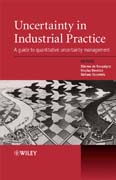
Uncertainty in industrial practice: a guide to quantitative uncertainty management
Rocquigny, Etienne de
There is a growing demand from institutional bodies for the justification of industrial methodologies and practices (e.g. safety criteria, environmental protection and control, maintenance and design optimization). Previous books in this area have either been too theoretical, or too specific in their scope. Uncertainty in Industrial Practice aims to provide a practical reference on uncertainty treatment for all types of industry, enabling the adoption of universal practices. The book is built upon a wide range of examples taken from withinrelevant industries, including nuclear technology, aeronautics, civil structures, and mechanical engineering. INDICE: Contents Preface Contributors Acknowledgements Introduction Notation Acronyms and abbreviations Part I Common Methodological Framework 1 Introducing the common methodological framework 1.1 Quantitative uncertainty assessment in industrial practice: a wide variety of contexts 1.2 Key generic features, notation and concepts 1.3 The common conceptual framework 1.4 Using probabilistic frameworks in uncertainty quantification preliminary comments 1.5 Concluding remarks References 2 Positioning of the case studies and study characteristics 2.1 Main study characteristics to be specified in line with the common framework 2.2 Introducing the panel of case studies 2.3 Case study abstracts Part II Case Studies 3 CO2emissions: estimating uncertainties in practice for power plants 3.1 Introduction and study context 3.2 The study model and methodology 3.3 Underlying framework of the uncertainty study 3.4 Practical implementation and results 3.5 Conclusions References 4 Hydrocarbon exploration: decision-support through uncertainty treatment 4.1 Introduction and study context 4.2The study model and methodology 4.3 Underlying framework of the uncertainty study 4.4 Practical implementation and results 4.5 Conclusions References 5 Determination of the risk due to personal electronic devices (PEDs) carried out on radio-navigation systems aboard aircraft 5.1 Introduction and study context 5.2 Underlying framework of the uncertainty study 5.3 Practical implementationand results 5.4 Conclusions References 6 Safety assessment of a radioactive high-level waste repositor comparison of dose and peak dose 6.1 Introduction and study context 6.2 Study model and methodology 6.3 Underlying framework of the uncertainty study 6.4 Practical implementation and results 6.5 Conclusions References 7 A cash flow statistical model for airframe accessory maintenance contracts 7.1 Introduction and study context 7.2 The study model and methodology 7.3 Underlying framework of the uncertainty study 7.4 Practical implementation and results 7.5 Conclusions References 8 Uncertainty and reliability study of a creep law to assess the fuel cladding behaviour of PWR spent fuel assemblies during interim dry storage 8.1 Introduction and study context 8.2 The study model and methodology 8.3 Underlying framework of the uncertainty study 8.4 Practical implementation and results 8.5 Conclusions References 9 Radiologicalprotection and maintenance 9.1 Introduction and study context 9.2 The study model and methodology 9.3 Underlying framework of the uncertainty study 9.4 Practical implementation and results 9.5 Conclusions References 10 Partial safetyfactors to deal with uncertainties in slope stability of river dykes 10.1 Introduction 10.2 The study model and methodology 10.3 Underlying framework of the uncertainty study 10.4 Practical implementation and results 10.5 ConclusionsReferences 11 Probabilistic assessment of fatigue life 11.1 Introduction and study context 11.2 The study model and methodology 11.3 Underlying framework of the uncertainty study 11.4 Practical implementation and results 11.5 Conclusions References 12 Reliability modelling in early design stages using the Dempster-Shafer Theory of Evidence 12.1 Introduction and study context 12.2 The study model and methodology 12.3 Underlying framework of the uncertainty study 12.4 Practical implementation and results 12.5 Conclusions References Part III Methodological Review and Recommendations 13 What does uncertainty management mean in an industrial context? 13.1 Introduction 13.2 A basic distinction between design and in-service operations in an industrial estate 13.3 Failure-driven risk management and option-exploring approaches at company level 13.4 Survey of the main trends and popular concepts in industry 13.5 Links between uncertainty management studies and a global industrial context 13.6 Developing a strategy to deal with uncertainties References 14 Uncertainty settings and natures of uncertainty 14.1 A classical distinction 14.2 Theoretical distinctions, difficulties and controversies in practical applications 14.3 Various settingsdeemed acceptable in practice References 15 Overall approach 15.1 Recalling the common methodological framework 15.2 Introducing the mathematical formulation of the measure of uncertainty, quantities of interest and key steps of a study 15.3 Links between final goals, study steps and feedback process 15.4 Comparison with applied system identification or command/control classics 15.5 Pre-existing or system model validation and model uncertainty 15.6 Links between decision theory and the criteria of the overall framework References 16 Uncertainty modelling methods 16.1 Objectives of uncertainty modelling and importantissues 16.2 Recommendations in a standard probabilistic setting 16.3 Commentson level-2 probabilistic settings References 17 Uncertainty propagation methods 17.1 Recommendations per quantity of interest 17.2 Meta-models 17.3 SummaryReferences 18 Sensitivity analysis methods 18.1 The role of sensitivity analysis in quantitative uncertainty assessment 18.2 Towards the choice of an appropriate Sensitivity Analysis framework 18.3 Scope, potential and limitations ofthe various techniques 18.4 Graphical methods 18.5 Conclusions References 19 Presentation in a deterministic format 19.1 How to present in a deterministic format? 19.2 On the reliability target 19.3 Final comments References 20 Recommendations on the overall process in practice 20.1 Recommendations on the key specification step 20.2 Final comments regarding dissemination challenges References Conclusion Appendices Appendix A A selection of codes and standards Appendix B A selection of tools and websites Appendix C Towards non-probabilisticsettings: promises and industrial challenges Index
- ISBN: 978-0-470-99447-4
- Editorial: John Wiley & Sons
- Encuadernacion: Cartoné
- Páginas: 368
- Fecha Publicación: 02/05/2008
- Nº Volúmenes: 1
- Idioma: Inglés
